Spotlight
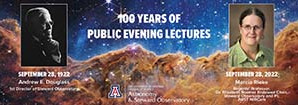
100 Years of Public Evening Lectures
Lavinia Steward made her historic contribution of $60,000 to the University of Arizona “…TO BUY TELESCOPE OF HUGE SIZE,” on October 18, 1916. However, the United States entry into World War I delayed the construction of the Steward Telescope and its 36-inch mirror. That original Steward Telescope was finally used for the first time on July 17, 1922. It would take another 9 months before the Steward Observatory and Telescope would be formally and officially dedicated on April 23, 1923.
The Telescope, however, was ready to be used before the official dedication date and Prof. Andrew Ellicott Douglass, the first Director of Steward Observatory, did not leave the telescope idle. He invited members of the campus and Tucson communities to view the wonders of the night sky through this new, large (for the time) telescope. The date was September 28, 1922, and the Steward Observatory Public Evenings were born.
We are thrilled to able to celebrate 100 years of presenting lectures on astronomy and telescope viewing to the public by offering a special Public Evening Lecture on the 100th Anniversary of the very first Steward Public Evening.
Lecture Information - Fall 2022 - Mark Your Calendars!
Monday, September 19
100 Years of Steward Observatory
Dr. Thomas Fleming and Dr. Buell Jannuzi, Steward Observatory
Wednesday, September 28 - Celebrating 100 Years!
The Webb Telescope: Starting Steward Observatory's Next 100 Years
Dr. Marcia Rieke, Regents Professor, Dr. Elizabeth Roemer Endowed Chair, Steward Observatory
Monday, October 3
Imaging Black Holes with the Event Horizon Telescope
Dr. Daniel Marone, Steward Observatory
Monday October 17
Floating Above Antarctica: The GUSTO Mission
Dr. Christopher Walker, Steward Observatory
Location: Steward Observatory N210
Doors open at 7:00 pm and Lectures begin at 7:30 pm MST
Nearest parking 2nd Street or Cherry Ave Garage
Telescope viewing follows at 8:30 PM - Weather Permitting
In-Person or Watch via NEW ZOOM link https://arizona.zoom.us/j/4470189357
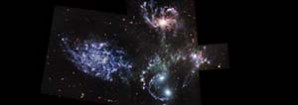
UA Astronomer, Dr. George Rieke, comments on new James Webb Space Telescope images
Regents' Professor George Rieke, the Science Lead for the JWST MIRI Instrument, gives us his view of the first images from JWST:
"It is gratifying to see how the first images and results from the James Webb Space Telescope have swept the world and given so many people a respite from humanity’s problems. If it is possible, it is even more gratifying to the teams at Steward Observatory who have been working and supporting the development of two of the four instruments on Webb – the Near Infrared Camera (NIRCam) and the Mid-Infrared Instrument (MIRI). Our roles in these instruments began more than twenty years ago for a few now-grizzled veterans, and as long as ten years ago for the many young astronomers who joined us. They took a huge gamble with their early careers by investing their energies in something with an uncertain and, on their timescale, far future payoff. But it has worked out for them, and amazingly well since the Webb observatory is working even better than predicted.
“Our” instruments showed what they can do in the Early Release Observations. NIRCam provided the ultra-deep image of the sky centered on a massive cluster of galaxies. It shows intriguing arcs of galaxies far behind the cluster, whose light has been bent by the gravitational field of the cluster and concentrated toward our direction. This is a foretaste of the large program we will be conducting over the next year to search for proto-galaxies back toward the birth of the Universe.
Both NIRCam and MIRI were featured in the image of the Stephan’s Quintet – five galaxies, of which four are interacting and in the process of merging. The image by MIRI shows spectacularly the flocculent structure of the interstellar gas and dust in one of the galaxies, and is symbolic of the new perspectives that this instrument will provide by observing at longer wavelengths than NIRCam.
The Southern Ring highlights both instruments. Although this planetary nebula is 2000 light years away, NIRCam resolves details as small as the Solar System, a foretaste of the incredible detail Webb will show us for everything it looks at. Both images, but particularly that from MIRI, reveal complex scallops of dusty shells. These were thrown off as a star went unstable and pulsated while gravity pulled it to its ultimate demise, with only its core surviving as a faint white dwarf star in the center of the nebula."
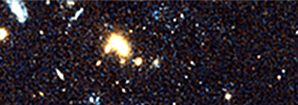
Young Stars in Dwarf Objects in a Hostile Galaxy Cluster Environment
Steward Postdoctoral Research Associate Michael Jones and Associate Professor David Sand have identified five instances of a new type of stellar system. You can see three images HERE and HERE and HERE. They are around a million times less massive than our galaxy, likely containing only 10,000 to 100,000 stars, which are arranged in a clumpy and irregular configuration. These systems, colloquially referred to as "blue blobs", are dominated by young, blue stars, yet are surprisingly isolated, typically over 300,000 lightyears from the nearest plausible parent galaxy. Furthermore, all five reside in the nearby Virgo galaxy cluster (approximately 50 million lightyears away). Galaxy clusters are filled with hot ionized gas at millions of degrees, making them an extremely hostile environment for the cold gas that is needed to form new stars. Even relatively large galaxies, similar in mass to our own Milky Way, rapidly lose their cold gas content after falling into a galaxy cluster. Yet these tiny "blue blobs" are floating alone, embedded in this hostile, hot medium, and are actively forming new stars. This raises the questions, where did they come from and how did they manage to become isolated while still so young.
To answer these questions Dr. Jones, Prof. Sand and Professor Kristine Spekkens (RMC, Kingston, Ontario) obtained Hubble Space Telescope and Very Large Array imaging of these systems, as well as observations with the Very Large Telescope in Chile, in collaboration with Dr. Michele Bellazzini (INAF, Bologna, Italy). These observations indicated that the "blue blobs" are rich in heavy elements, which is strong evidence that they formed from gas stripped from a large galaxy that had accumulated these elements as it built up its stellar mass over a long history. Material can be stripped from galaxies in two main ways, tidal stripping and ram pressure stripping. Tidal stripping occurs when two galaxies pass close by each other (or even merge) and their gravity pulls apart their outskirts, resulting in long tails of stripped material. Ram pressure stripping occurs when a galaxy moves rapidly through a gas medium, which forces its own gas out behind it. In either scenario, stripped gas clouds can collapse and form new stellar systems, analogous to "blue blobs." However, ram pressure stripping when galaxies fall into a cluster can occur at very high velocity (higher than can be achieved with tidal stripping) and this offers an explanation for how such young objects can be so isolated; they are just moving at very high speeds, perhaps over 500 miles per second.
These results were presented on Wednesday June 15th at a AAS 240 press briefing, and an accompanying UA press release. Check these out for more details.
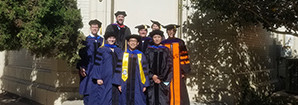
Recent Advanced Degrees at Astronomy/Steward
Since May 1, 2022, three Astronomy grad students have received Doctorates: Katrina Litke Marslender on May 3, Ryan Endsley on May 18, and Minghao Yue on May 19.
Photos can be seen HERE, HERE, and HERE. Congratulations to all of you, we are proud of you.
Also, in May, 2022, Hector Rico of the Department Office received his Master's degree in Public Health with an emphasis in Health Services Administration. A photo of a celebration in the Dept. Office can be seen HERE.
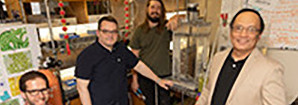
Using Algae to Capture Carbon
UA Astronomy and Planetary Science Professor Daniel Apai and Research Associate Martin Schlecker are working on a novel, scalable solution to remove carbon dioxide from the atmosphere to help mitigate the worst impacts of climate change. The project idea was inspired by Apai’s astrobiology research on habitable exoplanets and long-term climate feedbacks that may stabilize the surface temperatures of those worlds. Their team is using a special type of microalgae to capture carbon dioxide. These microalgae use energy from photosynthesis to extract carbon dissolved in the ocean to build shells made of calcium carbonate, a highly stable mineral. As the algae can divide several times a day, they offer a highly scalable, natural solution for large-scale atmospheric carbon dioxide removal.
The University of Arizona press release can be found HERE.
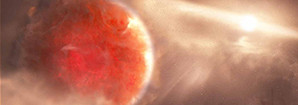
Imaging of Planets Embedded in a Protoplanetary Disk
Astronomers at The University of Arizona, including Glenn Schneider, Olivier Guyon, and Kevin Wagner, were recent co-authors on a study that used the Subaru/SCExAO instrument along with the Hubble Space Telescope to uncover some of the first images of a planet (the planet is at the center-bottom in the cover photo to our web story) in the process of forming within its protoplanetary disk. AB Aurigae b, at 90 au from the star and still embedded within its disk, is seen driving spiral arms and clearing an inner gap within the disk of gas and dust. This giant planet is among the youngest known and provides an opportunity to learn about how very massive planets form and interact with their parent disks.
AB Aurigae b is the first planet discovered by SCExAO at the Subaru telescope, which was led and developed by Professor Guyon. Images from the HST work can be seen HERE. For moreinformation, see the original paper (Currie et al. 2022, can't be seen without a subscription to Nature) HERE and the University of Arizona press release HERE.
The Sky and Telescope story is HERE.
Pages

For Public
Public events include our Monday Night Lecture Series, world-reknowned Astronomy Camp and Mt Lemmon Sky Center.

For Students
A good place to start if you want to become an undergrad major or grad student, or need to find our schedule of classes.

For Scientists
Find telescopes and instruments, telescope time applications, staff and mountain contacts, and faculty and staff scientific interests.




